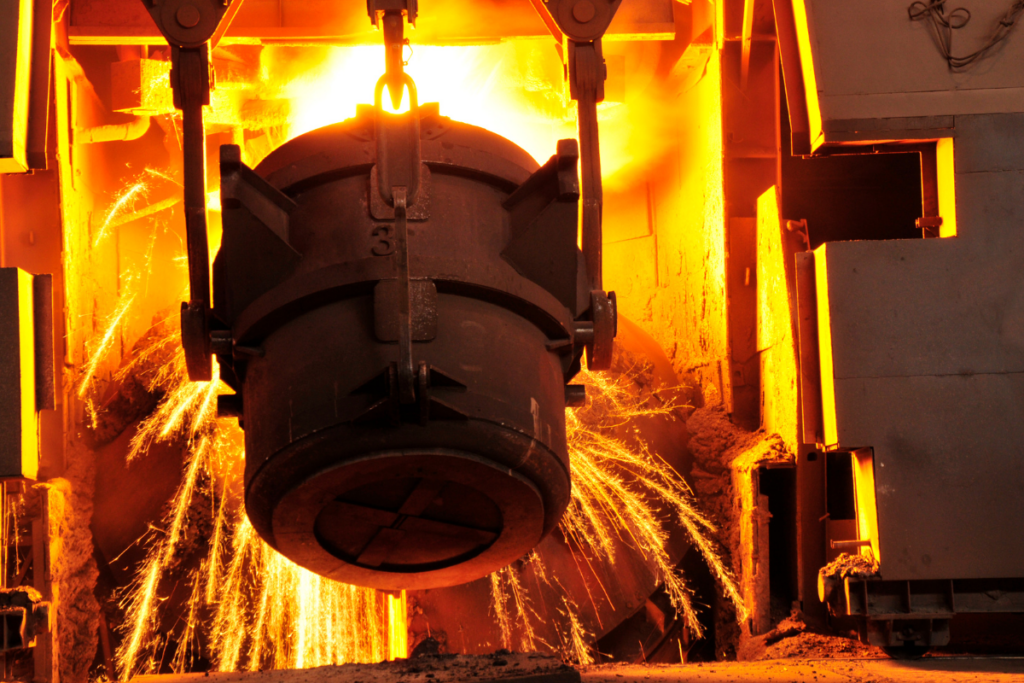Our precision machining experts at Arrow’s Kenona facility specialize in making design and fabrication recommendations to bring our customers high-quality products that ensure reliable performance and durability.
One of the factors we examine during the design phase is which materials would work best for the project’s application. In some cases, we may recommend gray or ductile iron castings for certain components as an alternative to steel.
Why Choose Iron Over Steel For Castings?
Although iron and steel may look and feel similar, they perform differently under certain conditions. As a result, there are many reasons why you might choose to use iron over steel for your product.
For example, iron can be easier to work with during the fabrication process. Iron has a lower melting point and lower viscosity than steel, making it easier to cast without shrinking as it cools.
Cast iron is also faster to produce than steel as the latter requires more processing, labor, and energy consumption to create before fabrication can begin. The additional steps, resources, and materials, such as chromium, needed to create steel can make it less cost-effective.
Another vital point to consider is each element’s strength. Where cast iron is stronger than steel, it will break under excessive pressure. Steel has more tensile strength, meaning it will bend to absorb more pressure without necessarily breaking, especially in the case of sudden impact.
Although both materials aren’t impervious to corrosion and decomposition when left exposed and subject to oxidation, cast iron is more rust-resistant than steel.
Our precision machine experts will work closely with you to determine the best material for your project. If cast iron is the recommended option, we drill a little deeper into whether gray or ductile iron is most appropriate.
What’s The Difference Between Gray Iron And Ductile Iron?
The main differentiator between gray and ductile iron is the type and structure of carbon each contains. Typically, gray iron runs 3.2 to 3.4 percent carbon while ductile runs 3.6 to 3.8 percent carbon. The amount of carbon helps determine the other key differences between gray and ductile iron, such as:
Ductility
Ductility refers to the material’s capacity to stretch thin when extreme pressure is applied. The addition of magnesium to ductile iron gives its graphite a nodular shape, which confers higher strength and ductility than flake-shaped gray iron.
Yield Strength
Yield strength is a measurement of the maximum stress a material can bear before its shape is permanently altered. Although gray iron has no measurable yield strength, its ductile counterpart is 40,000 psi.
Tensile Strength
The maximum stress a material can bear before breaking when stretched or pulled is known as its tensile strength. Ductile iron has a minimum tensile strength of 60,000 psi, making it much more durable than gray iron, which has a tensile strength range of 20,000 – 60,000 psi.
Thermal Conductivity
gray iron has a very high thermal conductivity because heat transfers through the graphite flakes. This makes gray iron an ideal choice for parts subject to thermal shock, such as brake drums. Conversely, ductile iron’s isolated spheres of graphite give it relatively low thermal conductivity.
Impact Strength
Ductile iron has a high ability to withstand impacts from a minimum of seven pounds. gray iron, by comparison, has an impact strength of two pounds. Its impact strength gives ductile iron the edge in critical applications where there is a risk of heavy impact.
Vibration Damping
Vibration damping dissipates vibration energy by absorbing or changing it to reduce the amount of energy transmitted through a piece of equipment or a structure. Gray iron exhibits non-elastic behavior at very low stresses, enhancing fatigue resistance and dampening vibration. Ductile iron is less effective at vibration dampening.
Read More: Reshaping The Metalworking Industry With Sustainable Material Sourcing
Which Type Of Iron Cast Is Best For My Application?
Gray iron’s high density, strength, light weight, and ability to dampen vibration make it an ideal material for construction equipment, valves, manhole covers, compressors, diesel engine parts, and transportation system components.
Ductile iron offers high impact strength, optimal wear resistance, and an ideal strength-to-weight ratio. These factors make it preferable to gray iron in many engineered applications, such as gearboxes, hydraulic valves, couplings, machine frames, pumps, and more.
Kenona engineers will ensure your project components are matched with the right material to ensure optimal quality and long-lasting performance you can count on. Get in touch with us today with your next project design to start collaborating!
Contact Kenona Industries For A Quote On Your Next Design And Fabrication Project
Kenona Industries is a world-class, high-volume, precision-made components supplier to leading automotive manufacturers. Discover everything that sets us apart by requesting a quote for your next project today!
